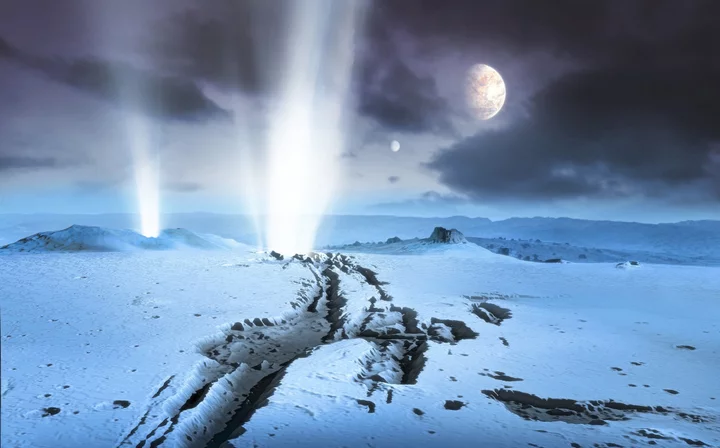The chance of finding worlds in the Milky Way with water — a basic requirement for Earth-like life — could be 100 times greater than previously thought, a new study finds.
NASA uses an old joke to explain why astronomers prioritize looking for signs of life throughout space on rocky planets similar to our own:
A police officer offers to help a man who's searching for his keys under a streetlight in the park. After a few minutes, the officer says, "Are you sure this is where you lost them?"
"No," the man says, "but the light is much better here."
Perhaps alien life could thrive in conditions unlike Earth, but it's easier for scientists to look for something familiar. That's why exoplanet hunters, those searching for worlds outside of this solar system, often focus on Earth doppelgangers in so-called "habitable zones." The concept, dating back to the 1950s, defines regions around a host star where it is not too hot or cold for liquid water to exist on a planet's surface. In this solar system, that sweet spot encompasses Venus, Earth, and Mars.
Today, scientists are realizing this notion is outdated, Lujendra Ojha, an astrophysicist at Rutgers University, told Mashable. He and a team of researchers used computer modeling to look at planets found around red dwarf stars, the most ubiquitous in the Milky Way. They concluded that even on exoplanets where the solar conditions aren't ideal for atmospheres and oceans, many would likely have internal sources of heat capable of creating lakes beneath ice sheets.
"If you were to ask any planetary scientist, 'Hey, after Earth, which body do you think is potentially most habitable?' most people would tell you that the next best place to look for life in the solar system is not Mars, not Venus, which are two planets in the habitable zone," he said. "It's places like Europa and Enceladus," two moons encased in ice in the outer solar system.
SEE ALSO: The curious planets scientists have ogled in 2023, so farScientists have previously estimated about one rocky planet per 100 stars has liquid water. But a study published in Nature Communications by this team, which considered the potential for water below ice, expands that probability about 100 times to one world for every star.
Israeli astrophysicist Amri Wandel, who was not involved in the research, wrote a commentary using this new data to advocate for broadening the Goldilocks boundaries for habitable planets to include potential worlds with "subglacial liquid water and life in colder planets and their satellites."
The number of confirmed exoplanets — planets orbiting stars other than the sun — has risen to 5,470, with 9,700 more candidates under review. Most of these are in the Milky Way, though scientists think they discovered the first planet within another galaxy two years ago.
Statistically speaking, the growing tally only scratches the surface of planets believed to be in space. With hundreds of billions of galaxies, the universe likely teems with many trillions of stars. And if most stars have one or more planets around them, that's an unfathomable number of worlds.
By drilling deep through the ice cover into lakes, scientists have discovered microorganisms known as psychrophiles, for example, that survive in the harsh environment. Credit: National Science Foundation Office of Polar ProgramsThe idea of flowing water underneath glaciers is not hypothetical — scientists have observed it here on Earth. They first discovered subglacial lakes several miles below the surface of Antarctica in the 1970s with radar. Since then, a team at Sheffield University in the United Kingdom has cataloged over 700 such bodies of water locked under ice throughout the world.
In these reservoirs, the heat that melts icy layers into lakes doesn't come from the sun but Earth itself. Natural radioactive elements found in everyday rocks — primarily uranium, thorium, and potassium — slowly decay, producing geothermal energy.
By drilling deep through the ice cover into these lakes, scientists have discovered microorganisms known as psychrophiles, for example, that survive in the harsh environment.
Europa, left, and Enceladus are two moons in the frigid outer solar system suspected to have oceans under icy shells. Credit: NASAWant more science and tech news delivered straight to your inbox? Sign up for Mashable's Light Speed newsletter today.
"Some of these lakes may have been isolated from the outside world for up to 35 million years, and may be final refuges for life, the like of which exists nowhere else on Earth," wrote Bethan Davies, a glaciologist, on the website she founded, AntarcticGlaciers.org.
Scientists have identified Enceladus, a moon of Saturn, as an icy world with an ocean beneath its surface. What gave away its secret were geyser-like plumes spraying water vapor more than 6,000 miles into space, roughly the distance of New York to Seattle and back. Mounting evidence points to the same phenomenon happening at Europa, one of Jupiter's moons. NASA plans to explore it with the uncrewed Europa Clipper mission, expected to launch as early as 2024.
Geyser-like plumes on Enceladus spew water vapor more than 6,000 miles into space. Credit: NASA / JPL-Caltech / SSI "If you were to ask any planetary scientist, 'Hey, after Earth, which body do you think is potentially most habitable?' most people would tell you that the next best place to look for life in the solar system is not Mars, not Venus, which are two planets in the habitable zone." Even Mars is suspected to have a subglacial lake under its south polar ice cap. Credit: NASA / JPL / MSSSEven Mars is suspected to have a subglacial lake under its south polar ice cap. An Italian research team published evidence from the European Space Agency's Mars Express spacecraft in the journal Science in 2018. The discovery bolsters the belief that the Red Planet could have hosted life at one time, possibly even still today.
About 4 billion years ago, when the sun wasn't as big and bright, Earth was a snowball covered in ice. Yet early Earth appears to have had liquid water that supported life. Scientists like Ojha think the solution to this mystery for our planet and ancient Mars is that other sources of heat allowed life to persist.
"On one hand, the astronomers are saying 'Hey, the sun just did not have enough power to cause water to flow.' And then when you talk to geologists, they say, 'Well, that's bullshit. Obviously, we see evidence of liquid water on both of these planets,'" he said. "The entirety of Earth was frozen for such a long period of time. Why didn't life just die off? The answer to that is related to geothermal heat."
A question astrobiologists want to answer is whether exoplanets orbiting red dwarf stars — about 70 percent of the stellar population in the galaxy — can have liquid water and potentially life. These stars are a mere fraction of the sun's size but burn extraordinarily bright, with toxic UV and X-rays. Recently, researchers have used the James Webb Space Telescope, the leading science observatory in space, to begin investigating the planets in the TRAPPIST-1 system, a red dwarf only 41 light-years away with seven Earth-size worlds.
So far, Webb has found a lack of atmospheres shielding these planets, perhaps because red dwarf stars are too violent. Though that could come as a letdown to people hopeful at least one of these worlds is covered in oceans, Ojha feels optimistic that even the harshest environments could harbor hidden reservoirs — and, thus, life.
After all, neither Europa nor Enceladus has an atmosphere.
"When you include this perspective," he said, "it's not necessary for the planet to be at the right place at the right time."









